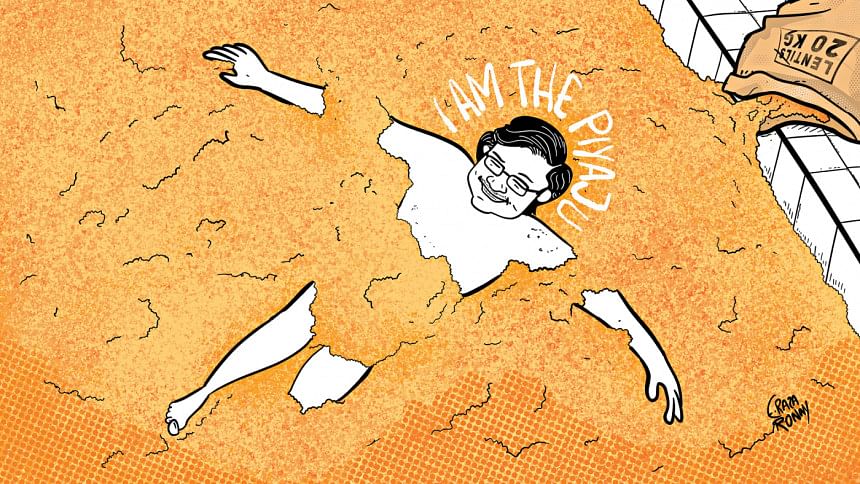How to Make Piyaju in Six Parts and Three Steps

-I-
I have two favourite t-shirts. One of them is blue. If given the choice, I would wear these t-shirts on any given day, for any occasion. This blue one has this image of a sunset on it, framed by brick red outcrops. The other shirt is also blue but it's a different shade gone slightly grey and to be honest, while it does have a spot in my heart, it's in a worn corner, in the smallest cockle.
There is also a third t-shirt that I would count as my favourite. It is black and I would wear it over the blue ones if I could ever find it. On the days I do, the world conspires to force me into wearing a button down. And with the resignation that comes from foresight, I pick out my despised gingham, knowing that I won't find this black shirt again. Weeks will pass and one day, there it will appear, in the dryer, freshly laundered and never worn.
I say this to you not because this is a personal essay but because I want to share with you the realization that sadness can be small but still significant. In nature, colours are often interpreted in shades of blue, grey and black because most animals are colour blind. Which explains why dogs love us so much; their monochrome world bestows a sort of uniformity to us. For true equality, you need to see the word like a dog. I read that somewhere.
Sometimes, your feelings are not lies.
-II-
The correct way to make a piyaju is to first contemplate the recipe and to decide to thoroughly compromise with the ingredients and instructions.
Your mother asked you to get two types of lentils, the orange ones and one of the innumerable yellow daals. The thing is, you can't spell kheshari in Bangla and while Google will come to your aid, the series of decisions that led you to this point in your life— alone in a kitchen with nothing but your thoughts— is not a good indicator of sound judgement. You have a jar of orange lentils of uncertain provenance and a year-old bag of yellow daals. Lentils are ancient grains, right? If they can survive the test of time, they can survive your cabinet. They haven't gone bad. And they're yellow. In nature, colours are often an indicator of texture and danger. Something about how luminous tropical frogs exist in a world of stark survival. I read that somewhere.
The lentils need to be soaked for at least four hours and while you know that there is obviously a reason for it you only just started and seriously, this is daal. You've made daal before. This is fine.
There was a time in your life when you needed nothing but the certain knowledge that your mother loved you.
Nostalgia can be torture.
Step 1: Wash the lentils over running water. Deposit them in a dark blue plastic bowl and let them soak for approximately 20 minutes. The volume of the water you soak them in, I leave to you and your God.
-III-
I have precisely six good pictures of myself. I think it's because I am the human equivalent of a Shetland pony; one of nature's more experimental monsters. I suppose in this era, with its profusion and obsession with images, six is a paltry number.
One picture is from a decade ago. I was tan then, well a darker shade of brown; burnt by a low sun in the lowlands. I was wearing a t-shirt that I no longer own, from a brand that I would now eschew, patterned yellow on black. I admit, even in that disaster of a shirt I looked good. I am not looking directly at the camera; I think it was at a farewell party.
The second picture I cannot accurately date but I think I'm nine in it. There's a dolphin, rising up out of a pool of water. The water is the slate grey of curdled dreams. A man, colourfully dressed and braver than I could ever hope to be, is blowing a whistle. I think the dolphin listens to him because of how brightly coloured he is. In nature, colours are often symbols of power. Whales are blue and they're bigger than dinosaurs. I read that somewhere.
The other three pictures were taken the same day and I don't remember them. I have seen them though; my mother takes great pleasure in their existence. In the photos, my mien has not yet blackened with cynicism. Possibly because I am one. I am dressed in a stark white sweater, blue striped. My cousin is there with me and there's a fern behind us.
If I could look anything like that again, I would collapse with joy.
-IV-
The recipe says to blend the lentils once they are done soaking. You can't blend them too much. Too fine a grind and they become dense when you shape them into piyajus. It's odd, the pieces add up to more than their sum. Cooking can be so philosophical. Unfortunately, the ability to discern between a fine blend and a coarse one requires impulse control. And simple control. Blending is fun. Look at it go.
Next, slice an onion. Measurements were spoken at you when you asked for the recipe but your mother also asked you if you were well and at that precise moment you coughed. You assure her that you've survived every single day of your life so far. It is not enough.
Into the sliced onions go chopped chilis. You are supposed to massage the salt into them which releases the moisture from the onions. Only then can you add the pinch of turmeric and a small amount garlic and ginger paste. This your mother assures you, is very controversial. Once you have your onion garnish, you fold in the coarsely blended lentils.
But hey, it's all going to be mixed together right? Why can't we just blend it all in? It's fine. You're only mildly tinged with hysteria. The onions somehow made the whole mess white and purple. In nature, colours are often seasonal and fleeting. Brightly coloured birds sometimes dance, flashing all their plumage in coruscating waves until the colours mix together. The movement is what matters, because nature loves entropy. I read that somewhere.
Sometimes, everything you do only makes you older.
Step 2: Throw it all into the blender and blend it at the highest setting. Blending is fun.
-V-
The first football jersey I ever bought wasn't actually a jersey but a t-shirt made of faux jean and it fit like a blanket. It was 3XL. It was this stone washed outre monstrosity being sold as promotional merch. It had World Cup on it, written in massive font with a picture of the actual cup and for some reason, Figo. It looked like a WWII-era restoration photo of a bombed-out landscape. I don't know if they were expecting something to happen.
I watched that World Cup mostly bemused and then increasingly anxious. I experienced heartbreak. Something about the way Klose's aquiline nose seemed to droop down with disappoint and pain. The yellow Ronaldo wore was so bright; Ronaldinho's smile like the cresting waves over a horizon only he could see.
I didn't ever grow into that t-shirt. It was too warm and it reminded me of Figo. It was also I think, not actually official World Cup merchandise and was very unbecoming. I loved it like a mother hen loves its unborn children. Something about the jeans texture and artificially faded colour appealed to me. It had no place in this world. In nature, colours are often different at different times of the day. Something about how a butterfly flaps its iridescent wings in the Amazon, we don't get to see it because everything is green in the morning. I read that somewhere.
You can only allow yourself to feel emotion when something causes you physical pain.
-VI-
When you've decanted the slop, it smells like your mother's kitchen did. Of course it does. It smells like raw onions.
The recipe tells you to shallow fry them and make sure the oil doesn't get too hot. The little blob of piyaju paste than you shape with your hands needs to be thin enough to get crispy. But it feels weird and you just can't get used to how it gets under your nails. And the oil, when does it get too hot? On your first piyaju nothing happened. Now it's smoking. When do you flip?
You remember the ardent joy of fasting in the winter, that first bite of piyaju. Your house smells so good now. You've used a spoon to plop little dollops into the frying pan. The first one has gone jet black. You pick out it's burnt husk. In nature, colours are often a form of communication. Something about how bees look at a daisy and feel lost. I read that somewhere.
Step 3: Fry the piyaju in oil. You'll get about 7 good ones that didn't burn. They won't taste bad. Serve with ketchup that's too sweet.
Perhaps the next time, you'll feel whole.

 For all latest news, follow The Daily Star's Google News channel.
For all latest news, follow The Daily Star's Google News channel. 



Comments